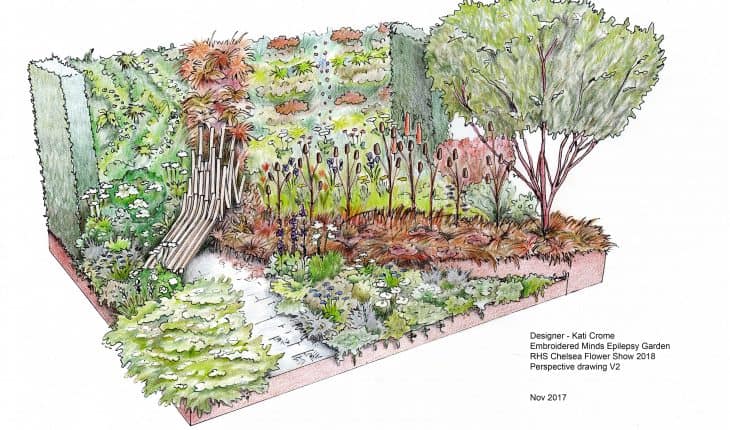Rebecca Wallersteiner takes a look at the tranquil ‘The Embroidered Minds Epilepsy Garden,’ – inspired by William Morris’ daughter Jenny’s epilepsy – designed by award winning designer Kati Crome at the Chelsea Flower Show 2018 and sponsored by the Epilepsy Society.
‘The Embroidered Minds Epilepsy Garden designed by award-winning garden designer Kati Crome is a garden that has an impact that stops you in your tracks and keeps you thinking long after the flowers have faded. Inspired by Leslie Forbes’ novel ‘Embroidered Minds of the Morris Women,’ – the garden explores William Morris’s daughter Jenny’s experience of epilepsy and the effects of her suffering had on the Morris family in the Victorian era when the condition carried a social stigma.
Award-winning garden designer Kati Crome, who created this stunning garden explains her personal inspiration behind the garden: “My great friend Leslie Forbes died suddenly as a result of an epileptic seizure just two months after offering to support a garden based on her book The Embroidered Minds of the Morris Women. I am so happy that I can help continue her project and help raise awareness of Epilepsy and hopefully help reduce the stigma surrounding the condition”
Crome continues, “I have learnt so much about Epilepsy on my journey to create The Embroidered Minds Epilepsy Garden and even before the RHS Chelsea Flower Show opens I have been hearing from people with the condition feeling so glad that we’re talking about the subject and raising awareness.”
In the nineteenth century family members with mental illness were hidden away, even by enlightened people. This included Victorian craftsman William Morris’ whose daughter Jenny developed epilepsy in 1876, a condition then carrying a huge social stigma. Keeping this secret had a profound effect on the whole family.
In the nineteenth century family members with mental illness were hidden away, even by enlightened people. This included Victorian craftsman William Morris’ whose daughter Jenny developed epilepsy in 1876, a condition then carrying a huge social stigma. Keeping this secret had a profound effect on the whole family.
By responding to this fascinating and little known history, the design of the garden aims to raise awareness of epilepsy and how it remains a challenge today. Researching her novel Leslie Forbes discovered that for 17 years during the late 1800s Morris had his studio and workshop in Queen Square next door to the National Hospital – which was at that time ‘birthplace of neurology’ and study into epilepsy (it was named The National Hospital for Epilepsy and Paralysis) – and is the leading neurological hospital in Britain today. After she started having epileptic seizures in 2005, which were caused by a brain tumour, Forbes herself was treated at the hospital and became intrigued by Jenny Morris’s story after the nurses recounted the story and she turned it into a novel, which inspired her friend Kati Crome’s ‘Epilepsy’ garden design for RHS Chelsea.
‘The garden’s planting palette was influenced by Morris’s designs for wallpaper and fabric,’ says Crome. The pre-seizure area of the garden is calm and sedate with mainly greens and whites, including Acanthus mollis used so often in Morris designs and Valeriana officinalis, which was one of the first epilepsy drugs. As you wander further into the garden, there is a sudden change of atmosphere and colour palette as a ‘seizure’ hits: here the plants are harsh and brown: different sedges Carex testacea, C. buchananii, C. comans, Rumex flexuosus, Geranium ‘Sanne’ and Oxalis corniculata, var, atropurpurea, and teasels (Dipsacus fullonum) drying on their stems from the previous year.
Deeper into the garden, the post seizure planting is more vivid with the use of orange spires of Eremurus and Iris ‘Casque d’Or’. The burnt orange of Physocarpus opulifolius Amber Jubilee (‘Jefam’) against blue Aquilegia vulgaris Vervaeneana Group and dark blue Iris ‘Sable’. The contrasting Aquilegia vulgaris ‘Black Barlow’ and Centaurea montana ‘Black Sprite’ with the whites of Paeonia ‘Claire de Lune’ and Cenolophium denudatum. A living green wall symbolises hope for the future.
An oak bench, tiled path and foreground garden are interrupted by planting representing a seizure, and more vivid planting representing the possible heightening of the senses post seizure.
A living green wall symbolises hope for the future.
An oak bench, tiled path and foreground garden are interrupted by planting representing a seizure, and more vivid planting representing the possible heightening of the senses post seizure.
Leslie Forbes sadly died in July 2016 after an epileptic seizure. By responding to her fascinating research into Jenny Morris’s silent suffering and her family’s experience of epilepsy, the design of the garden aims to raise awareness of epilepsy and how it remains a challenge today.
A seasoned Flower show exhibitor, Kati Crome’s gardens have been admired by thousands of visitors and won many prizes. Given the beauty and detail of her latest ‘The Embroidered Minds Epilepsy Garden’ for RHS Chelsea, it should attracts crowds of admirers this summer.
Andrew Thomas Leslie Forbe’s husband is the main sponsor of the garden which is part sponsored by The Epilepsy Society and includes plants grown by students from charity Young Epilepsy. www.youngepilepsy.org.uk
- People’s Choice Victory for Down’s Syndrome Scotland Garden at Chelsea 2025 - 28th May 2025
- Cadogan: A Chelsea Family By Tamsin Perrett - 3rd May 2025
- Dream Worlds a new exhibition in Cambridge - 14th December 2024







